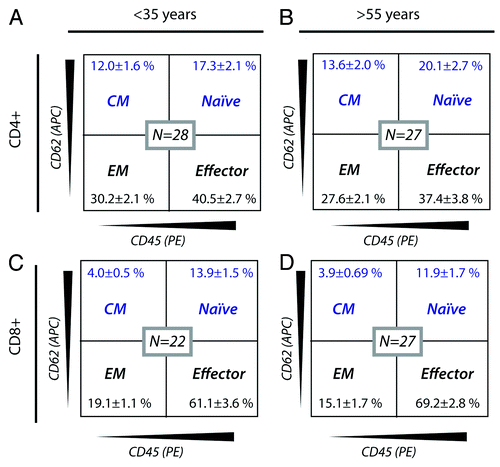Abstract
Aging of the human body affects the immune system by a decline in the ability to raise a response to challenges such as microbial infections or vaccinations. In the very elderly, the decline in such functions appears to relate to a reduced expression of certain co-stimulatory molecules expressed by T lymphocytes. More recently, attention has been drawn to the adhesion molecule CD62L, where differences in expression and function of this molecule between younger and older individuals are suspected to be a part of immunosenescence in the elderly.
Keywords: :
Sir,
Shin and Bayry commented on our recent report,Citation1 which addressed certain observations on the CD62L expression and the ability to form specific antibodies to the Hepatitis B surface antigen. We reported that a positive correlation between the expression of this molecule and the ability to form such specific antibodies was found in a cohort of young individuals (mean age 33 y) while this correlation was not found in a cohort of elder individuals (mean age 62 y). Neither the expression of CD62L nor the ability to bind the ligand for CD62L was reduced in the elderly individuals. From these findings we hypothesized that the observed CD62L expression level in the elderly involved a response compensating a possible lack of carbohydrate ligand for CD62L.
In their correspondence, Shin and Bayry now points to a report by Ohyashiki et al., which show a surprisingly strong negative correlation between the percentage of CD3+CD8+CD62L+ T lymphocytic subset of peripheral blood mononuclear cells and age in a range approximately from 20 to 60 y.Citation2 Correlations involving the micro RNA miR-92a further prompted Ohyashiki et al. to suggest miR-92a as part of the regulatory potential controlling CD62L expression.
In principle, we agree with Shin and Bayry that this is an interesting observation with regard to the regulation of CD62L expression. However, as part of their correlation analyses Ohyashiki et al. found an approximately 4-fold reduction in the percentage of CD3+CD8+CD62L+ T lymphocytes in individuals in their late fifties (at ~5%) compared with individuals in the early 20s (at ~18%).Citation2 De Martinis et al. also reported a significant age-related reduction in the percentage of CD62L expressing T lymphocytes, but only 1.5-fold (from 81% to 53%) when comparing the naïve lymphocytes from a group of young individuals with a mean age of 30 y (n = 10) with the same subset from a group of very elderly individuals with a mean age of 90 y (n = 10).Citation3 In the case of central memory T cells, the reduction was only 1.2-fold (from 64% to 55%). However, De Martinis et al. did not stratify the T lymphocytes into CD4 and CD8 positive subsets.
Our studyCitation1 also generated data on the percentages of CD62L positive T lymphocytes (). We were not able to find any major difference in the distribution of naïve, effector, effector memory (EM), and central memory (CM) T lymphocyte subsets. For both age groups, the percentage of CD3+CD4+CD62L+ cells were at ~30% while the CD3+CD8+CD62L+ cells constituted ~18%, quite similar to the level reported by Ohyashiki et al. for individuals in their early 20s.Citation2
Figure 1. Distribution of CD45+CD62L+ (naïve), CD45+CD62L- (effector), CD45-CD62L- (effector memory, EM), and CD45-CD62L+ (central memory, CM) T lymphocytes in peripheral blood mononuclear cells. Percentage of each subset is stated as the mean ± SEM. The number of donors included in each analysis is stated as N. Experimental protocols and other data from these analyses were reported earlier by Rosenberg et al.Citation1 (A and B) CD3+CD4+ (A) and CD3+CD8+ (B) T lymphocyte subset distribution in donors younger 35 y. (C and D). CD3+CD4+ (C) and CD3+CD8+ (D) T lymphocyte subset distribution in donors older 55 y.

Taken together, we are hesitant to agree that the CD62L expression in general is significantly reduced as a consequence of increasing age in the interval from young to elderly. Indeed, in a broader context, age-related attenuation of receptor expression and their functions in lymphocytes identified such phenomena only when comparing groups with relatively extreme age differences unlike the donors in our study.Citation4,Citation5 At present, however, age-related differences in CD62L expression and their functional consequences have been the topic of a limited number of studies. In our opinion the studies Ohyashiki et al.Citation2 and De Martinis et al.Citation3 as well as others are welcome contributions to the important topic of molecular mechanisms of immunosenescence.
Disclosure of Potential Conflicts of Interest
No potential conflicts of interest were disclosed.
References
- Rosenberg C, Bovin NV, Bram LV, Flyvbjerg E, Erlandsen M, Vorup-Jensen T, Petersen E. Age is an important determinant in humoral and T cell responses to immunization with hepatitis B surface antigen. Hum Vaccin Immunother 2013; 9:1466 - 76; http://dx.doi.org/10.4161/hv.24480; PMID: 23571167
- Ohyashiki M, Ohyashiki JH, Hirota A, Kobayashi C, Ohyashiki K. Age-related decrease of miRNA-92a levels in human CD8+ T-cells correlates with a reduction of naïve T lymphocytes. Immun Ageing 2011; 8:11; http://dx.doi.org/10.1186/1742-4933-8-11; PMID: 22082184
- De Martinis M, Modesti M, Profeta VF, Tullio M, Loreto MF, Ginaldi L, Quaglino D. CD50 and CD62L adhesion receptor expression on naive (CD45RA+) and memory (CD45RO+) T lymphocytes in the elderly. Pathobiology 2000; 68:245 - 50; http://dx.doi.org/10.1159/000055933; PMID: 11493756
- Weng NP, Akbar AN, Goronzy J. CD28(-) T cells: their role in the age-associated decline of immune function. Trends Immunol 2009; 30:306 - 12; http://dx.doi.org/10.1016/j.it.2009.03.013; PMID: 19540809
- Jalilian B, Christiansen SH, Einarsson HB, Pirozyan MR, Petersen E, Vorup-Jensen T. Properties and prospects of adjuvants in influenza vaccination - messy precipitates or blessed opportunities? Mol Cell Ther 2013; 1.
